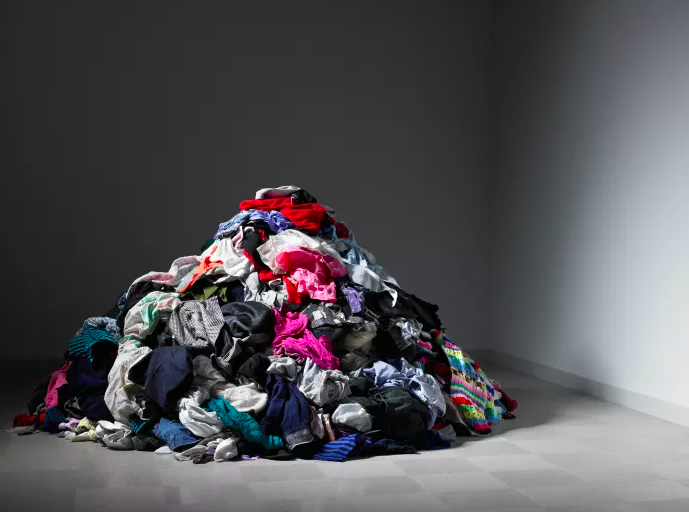Fashion is a Waste Industry
New York Fashion Week is officially over (and so is the Westminster Dog Show). New York can return to its normal chaos and enjoy fewer crowds…for the time being.
Whenever fashion week arrives, on the street or the Instagram feed, the waste is palpable. The excess of the fashion industry is on full display. Each runway show hands out goodie bags of individually packaged items. Brands display their wares down the runway as the symbolic marker of another season of fast fashion and mass production. Plastic water bottles litter the street. With over 230,000 attendees and 300 shows in one week, sustainability is the last thought during fashion week, if a thought at all.
However, the fashion industry is one of the largest, albeit understated, culprits of waste in the United States. According to the EPA, discarded clothes are the main textiles found in Municipal Solid Waste (MSW)–aka landfill waste. In 2015, about 16 million tons of textiles were produced. 65% of those textiles ended up in a landfill.
Not to mention that plastics from clothing fibers often end up in what becomes polluted oceans. Additionally, clothing donations get dropped in developing countries like bombs to sit for years emitting toxic gases. Global clothing production has increased two-fold over the past two decades, which means the detrimental effects increase as well.
That is not to say that fashion is, hard line, bad. Fashion is representative, it’s cultural, it makes us feel good! However, we must hold the fashion industry to the same sustainability standards we ask of our food and energy producers. And we must reorient our relationship to the fashion we choose to wear by investing in durable items form conscientious brands.
Sustainable Fashion Day
This past fashion week, Planet Fashion TV hosted a Sustainable Fashion Day event. The night showcased a range of innovative designers and producers at the forefront of the sustainable fashion movement.
The night began with a panel session between Planet Fashion producer, Celia Evans and Kat Maryfield. Maryfield is the owner of Kat’s Naturals, an organic cosmetic line that pairs the beneficial power of CBD with the skins natural chemicals for enhancing results. And of course, everyone present got to take home a sample.
The next panel featured clothing designer Bridgett Artise, and Angela Clark, a jewelry designer who salvages old stones and gems. Artise uses old clothes, from thrift stores or personal donations, and amends the items using stitch and patchwork. This process, which maintains the original article of clothing but gives it new life, is known as upcycling. Similarly, Clark keeps found gems and stones in their original condition because, as she says, it has already lasted so long! Both women focused on repurposing items already in existence to reduce waste in the fashion industry.
The final panel featured Stacy Change of Veerah shoes and Oliver Tolentino, a high-end fashion designer. Veerah uses organic materials such as apple skins and algae foam to make elegant footwear. Stacy began her shoe line because she wanted to “align her values with her closet.”
Tolentino, a local LA designer, displayed his eco gown line at his first ever fashion week appearance. For his eco line, Tolentino, remarkably, uses pineapple fibers to weave the fabrics that form his gowns. The end result is completely compostable! Tolentino derives the pineapple fiber and weaving techniques from Philippine tradition. Thus, his product is sustainable two times over: he uses natural materials and traditional techniques that sustain economic growth in small villages.
After the panel discussions concluded the audience had a chance to ask questions which made the experience feel collaborative–as if we were all there to reach a solution together. Then for the main event, the fashion show! It was amazing to see what sustainable fashion looked like: beautiful, original, and overall, not that different from physically “new” fashion. The main difference being that you can feel better wearing it.
Future of Fashion
Hopefully, Sustainable Fashion Day is the beginning of a new trend. Sustainable clothing is marketable and fashionable! It is time to revert back to longevity and turn away from fast fashion. However, there is still a long way to go. The fashion industry is also responsible for criminal workforce practices, toxic levels of carbon dioxide production, and the list goes on. The important message to take away from Sustainable Fashion Day is that environmental degradation infiltrates all sectors of our lives. There is always room for us to make more informed and sustainable decisions to protect our planet and ourselves.
Written by Mollie Wodenshek for FutureAir
Reference
Cooper, Kelly-Leigh, “Fast fashion: Inside the fight to end the silence on waste,” BBC: News.
EPA, “Textiles: Material-Specific Data,” United States Environmental Protection Agency.
Photo
iStock

